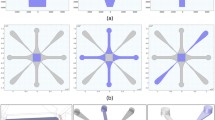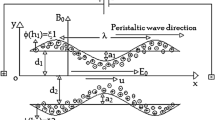Abstract
The objective of this work is to create a finite element model of different magnetic actuator topologies using COMSOL Multiphysics software. The aim is to simulate and improve the magnetic field generated by different planar microcoil topologies while minimising energy dissipation. The magnetic field generated by square and circular spiral planar microcoils was compared with that produced by serpentine meander planar microcoils. It has been found that the trapping efficiency in a magnetic manipulation microfluidic system for biological applications is closely linked to the geometry and electrical parameters of the planar microcoils. In addition, the location of these microcoils within the microfluidic channel intended for the circulation of the paramagnetic microbeads also play a crucial role. The obtained results show that bu reducing the inter-turn spacing using a thinner conductor cross-section and injected a higher electrical intensity in the actuator, both the magnetic field strength and its gradient can be increased, and therefore cause a higher magnetic actuation force.












Similar content being viewed by others
Data availability
The simulation data used in this study are described in detail in the paper.
Abbreviations
- A :
-
Magnetic vector potential, T m, or Wb/m
- B:
-
Magnetic field density, T
- e s :
-
Conductor thickness, m
- E is :
-
Inter-turn spacing, m
- H:
-
Magnetic field strength, A/m
- Fm :
-
Magnetic force, N
- I:
-
Current intensity, A
- J:
-
Current density, A/m2
- L s :
-
Conductor width, m
- m:
-
Magnetic moment, A m2
- M:
-
Magnetization, A/m
- n :
-
Turns number, –
- V :
-
Volume, m3
- V m :
-
Magnetic scalar potential, V
- Δχ:
-
Effective magnetic susceptibility of the particle relative to medium, -
- Χ:
-
Magnetic susceptibility, –
- µ0 :
-
Magnetic permeability of vacuum, H/m
- μr :
-
Relative permeability, –
- σ:
-
Electric conductivity, S/m
References
Agiotis L, Theodorakos I, Samothrakitis S, Papazoglou S, Zergioti I, Raptis YS (2016) Magnetic manipulation of super-paramagnetic nanoparticles in a microfluidic system for drug delivery applications. J Magn Magn Mater 401:956–964
Ahmadpour S-S, Navimipour NJ, Mosleh M, Bahar AN, Yalcin S (2023a) A nano-scale n-bit ripple carry adder using an optimized XOR gate and quantum-dots technology with diminished cells and power dissipation. Nano Commun Netw 36:100442
Ahmadpour S-S, Navimipour NJ, Nawaz BA, Mosleh M, Senay Y (2023b) An energy-aware nanoscale design of reversible atomic silicon based on miller algorithm. IEEE 23:2168–2364
Ahmadpour S-S, Heidari A, Navimpour NJ, Asadi M-A, Senay Y (2023c) An efficient design of multiplier for using in nano-scale IoT systems using atomic silicon. IEEE Internet Things J 10(16):2327–4662
Becker EW, Ehrfeld W, Hagmann P, Maner A, Munchmeyer D (1986) Fabrication of microstructures with high aspect ratios and great structural heights by synchrotron radiation lithography, galvanoforming, and plastic moulding (LIGA process). Microelectron Eng 4:35–56
Beebe DJ, Mensing GA, Walker GM (2002) Physics and applications of microfluidics in biology. Annu Rev Biomed Eng 4:261–286
Bojko P, Durett AG, Hester JP, Korbling M (1995) Magnetic cell sorting (MACS) to purify G-CSF mobilized and apheresis collected CD34+ progenitor cells for transplantation. Blood 86:904
Cao Q, Fan Q, Chen Q, Liu C, Han X, Li L (2020) Recent advances in manipulation of micro-and nano-objects with magnetic nanoparticles objects with magnetic fields at small scales. Mater Horiz 7:2028–2046
COMSOL Multiphysics Reference Manual, version 3.5, COMSOL, Inc, http://www.comsol.com.
Deman AL, Le Roy D (2020) Magnetophoresis in bio-devices. In: book. Engineering of micro/nano Biosystems. Springer, Singapore, pp 309–361
Deng T, Whitesides GM, Radhakrishnan M, Zabow G, Prentiss M (2001) Manipulation of magnetic microbeads in suspension using micromagnetic systems fabricated with soft lithography. Appl Phys Lett 78:1775–1777
Doerr A (2009) Microfluidics for the people. Nat Methods 6:194
Duffy DC, McDonald JC, Schueller OJA, Whitesides GM (1998) Rapid prototyping of microfluidic systems in poly(dimethylsiloxane). Anal Chem 70:4974–4984
Fair RB (2007) Digital microfluidics: is a true lab-on-a-chip possible? Microfluid Nanofluid 3:245–281
Franke TA, Wixforth A (2008) Microfluidics for miniaturized laboratories on a chip. Chemphyschem Eur J Chem Phys Phys Chem 9(15):2140–2156. https://doi.org/10.1002/cphc.200800349
Fujii T (2002) PDMS-based microfluidic devices for biomedical applications. Microelectron Eng 61–62:907–914
Fulcrand R (2009) Etude et développement d’une plateforme microfluidique dédiée à des applications biologiques Intégration d’un actionneur magnétique sur substrat souple. Universtié Paul- Sabatier Toulouse III, Toulouse
Fulcrand R, Jugieu D, Escriba C, Bancaud A, Bourrier D, Boukabache A, Gue AM (2009) Development of a flexible microfluidic system integrating magnetic micro-actuators for trapping biological species. J Micromech Microeng 19(10):105019
Gijs MAM (2004) Magnetic bead handling on-chip: new opportunities for analytical applications. Microfluid Nanofluid 1:22–40
Gijs MAM, Lacharme F, Lehmann U (2010) Microfluidic applications of magnetic particles for biological analysis and catalysis. Chem Rev 110:1518–1563
Guesdon JL, Avrameas S (1981) Magnetic solid-phase enzyme immunoassay for the quantitation of antigens and antibodies: application to human immunoglobulin E. Methods Enzymol 73:471–482. https://doi.org/10.1016/0076-6879(81)73086-6
Haeberle S, Zengerle R (2007) Microfluidic platforms for lab-on-a-chip applications. Lab Chip 7:1094–1110
Hafelli U, Schutt W, Teller J, Zborowski M (1997) Scientific and clinical applications of magnetic carriers. In: Physics of magnetic cell sorting. Plenum Press, New York, pp 205–231
Inglis DW, Riehn R, Sturm JC, Austin RH (2006) Microfluidic high gradient magnetic cell separation. J Appl Phys 99:08K101
Irwin P, Damert W, Tu SI (2003) Immuno-magnetic bead mass transport and capture efficiency at high target cell densities in phosphate-buffered saline. J Rapid Methods Autom Microbiol 11:265–284
Jiang Z, Llandro J, Mitrelias T, Bland JAC (2006a) An integrated microfluidic cell for detection, manipulation, and sorting of single micron-sized magnetic beads. J Appl Phys 99:08S105
Jin DB, Li JX, Cai W, Tu L, Chen J, Wu Q, Wang WH (2015) A microfluidic device enabling high-efficiency single cell trapping. Biomicrofluidics 9(1):014101
Jo BH, Van Lerberghe LM, Motsegood KM, Beebe DJ (2000) Three-dimensional micro-channel fabrication in polydimethylsiloxane (PDMS) elastomer. J Microelectromech Systems 9(1):76–81
Kawaguchi H (2000) Functional polymer microspheres. Prog Polym Sci 25(8):1171–1210
Kim KS, Park JK (2005) Magnetic force-based multiplexed immunoassay using superparamagnetic nanoparticles in microfluidic channel. Lab Chip 5:657–664
Kim Y, Hong S, Lee SH, Lee K, Yun S, Kang Y, Paek K-K, Ju B-K, Kim B (2007) Novel platform for minimizing cell loss on separation process: droplet-based magnetically activated cell separator. Rev Sci Instrum 78:074301
Krishnapriya S, Rama K, Suja KJ (2016) Significance of non-spiral planar microcoils over spiral coils for biomedical applications. In: Proceedings of IEEE international conference on emerging electronics, IIT Bombay, pp 1–4
Krishnapriya S, Himanshu C, Rama K, Suja JK (2018) Electromagnetic microactuators using non-spiral planar microcoils for robotic applications. Procedia Comput Sci 133:545–552
Kuhara M, Takeyama H, Tanaka T, Matsunaga T (2004) Magnetic cell separation using antibody binding with protein an expressed on bacterial magnetic particles. Anal Chem 76(21):6207–6213
Lacharme F, Vandevyver C, Gijs MAM (2008) Magnetic beads retention device for on-chip sandwich immuno-assay. In; Mems: 21st IEEE international conference on micro electromechanical systems. Technical Digest, pp 184–187
Lee CS, Lee H, Westervelt RM (2001) Microelectromagnets for the control of magnetic nanoparticles. Appl Phys Lett 79:3308–3310
Lee KB, Park S, Mirkin CA (2004) Multicomponent magnetic nanorods for biomolecular separations. Angew Chem Int Ed 43:3048–3050
Lefebvre O, Smadja C, Martincic E, Woytasik M, Ammar M (2017) Integration of microils for on-chip immunosensors based on magnetic nanoparticles capture. Sens Bio-Sens Res 13:115–121
Liu TY, Hu SH, Liu KH, Shaiu RS, Liu DM, Chen SY (2008) Instantaneous drug delivery of magnetic/thermally sensitive nanospheres by a high-frequency magnetic field. Langmuir 24:13306–13311
Makker K, Agarwal A, Sharma RK (2008) Magnetic activated cell sorting (MACS): utility in assisted reproduction. Indian J Exp Biol 46(7):491–497
Manz A, Graber N, Widmer HM (1990) Miniaturized total chemical analysis system: a novel concept for chemical sensing. Sens Actuators B1:244–248
Massin C, Vincent F, Homsy A, Ehrmann K, Boero G, Besse PA, Daridon A, Verpoorte E, de Rooij NF, Popovic RS (2003) Planar microcoil-based microfluidic NMR probes. J Magn Reson 164:242–255
McCloskey KE, Chalmers JJ, Zborowski M (2003) Magnetic cell separation: characterization of magnetophoretic mobility. Anal Chem 75:6868–6874
Molday RS, Yen SPS, Rembaum A (1977) Application of magnetic microspheres in labeling and separation of cells. Nature 268:437–438
Muluneh M, Issadore D (2014) Microchip-based detection of magnetically labeled cancer biomarkers. Adv Drug Deliv Rev 66:101–109
Neagu CR, Jansen HV, Smith A, Gardeniers JGE, Elwenspoek MC (1997) Characterization of a planar microcoil for implantable microsystems. Sens Actuators A Phys 62:599–611
Pamme N (2006) Magnetism and microfluidics. Lab Chip 6:24–38
Pamme N (2012) On-chip bioanalysis with magnetic particles. Curr Opin Chem Biol 16(3–4):436–443
Pawinanto RE, Yunas J, Majlis BY, Bais B, Said MM (2015) Fabrication and testing of electromagnetic mems microactuator utilizing pcb based planar micro-coil. ARPN J Eng Appl Sci 10(18):8399–84034
Pawinanto RE, Yunas J, Said MM, Noor MM, Majlis BY (2014) Design and fabrication of PCB based planar microcoil for magnetic MEMS actuator. In: IEEE-ICSE2014 Proc. Kuala Lumpur, Malaysia
Pichl L, Heitmann A, Herzog P, Oster J, Smets H, Schottstedt V (2005) Magnetic bead technology in viral RNA and DNA extraction from plasma minipools. Transfusion 45(7):1106–1110
Porter J, Pickup RW (1998) Separation of natural populations of coliform bacteria from freshwater and sewage by magnetic-bead cell sorting. J Microbiol Methods 33(3,1):221–226
Pramanik AK, Mahalat MH, Pal J, Ahmadpour S-S, Sen B (2023) Cost-efective synthesis of QCA logic circuit using genetic algorithm. J Supercomput 79:3850–3877
Ramadan Q, Samper V, Poenar D, Yu C (2004) On-chip micro-electromagnets for magnetic-based bio-molecular separation. J Magn Magn Mater 281:150–172
Ramadan Q, Samper VD, Puiu DP, Yu C (2006) Fabrication of three-dimensional magnetic microdevices with embedded microcoils for magnetic potential concentration. J Microelectromech Syst 15:624–638
Reyes DR, Iossifidis D, Auroux P-A, Manz A (2002) Micro total analysis systems. 1. Introduction, theory, and technology. Anal Chem 74(12):2623–2636
Rong R, Jin-Woo C, Chong HA (2006) An on-chip magnetic bead separator for biocell sorting. J Micromech Microeng 16:2783
Smistrup K (2007) Magnetic separation in microfluidic systems. PhD thesis, Technical University of Denmark
Smistrup K, Hansen O, Bruus H, Hansen MF (2005) Magnetic separation in microfluidic systems using microfabricated electromagnets—experiments and simulations. J Magn Magn Mater 293(1):597–604
Tartaj P, Morales MD, Veintemillas-Verdaguer S, Gonzalez-Carreno T, Serna CJ (2003) The preparation of magnetic nanoparticles for applications in biomedicine. J Phys D Appl Phys 36(13):R182–R197
Vuosku J, Jaakola L, Jokipii S, Karppinen K, Kamarainen T, Pelkonen VP, Jokela A, Sarjala T, Hohtola A, Haggman H (2004) Does extraction of DNA and RNA by magnetic fishing work for diverse plant species? Mol Biotechnol 27:209–215
Whitesides GM (2006) The origins and the future of microfluidics. Nature 442:368–373
Whitesides GM, Ostuni E, Takayama S, Jiang X, Ingber DE (2001) Soft lithography in biology and biochemistry. Annu Rev Biomed Eng 3:335–373
Yokokawa R, Yoshida Y, Takeuchi S, Kon T, Fujita H (2006) Unidirectional transport of a bead on a single microtubule immobilized in a submicrometre channel. Nanotechnology 17:289–294
Zhang T, Zhang P, Li HW, Wu YH, Liu YS (2008) Fabrication of micro electromagnetic actuator of high energy density. Mater Chem Phys 108:325–330
Zishan A, Poenar DP, Aditya S (2017) Design of planar microcoil-based NMR probe ensuring high SNR. AIP Adv 7:095107
Acknowledgements
The authors would like to acknowledge the General Directorate of Scientific Research and Technological Development (DGRSDT) of Algeria and LABAB Laboratory of National Polytechnic School of Oran (Algeria). The comments from the reviewer are also greatly acknowledged.
Author information
Authors and Affiliations
Corresponding author
Additional information
Publisher's Note
Springer Nature remains neutral with regard to jurisdictional claims in published maps and institutional affiliations.
Rights and permissions
Springer Nature or its licensor (e.g. a society or other partner) holds exclusive rights to this article under a publishing agreement with the author(s) or other rightsholder(s); author self-archiving of the accepted manuscript version of this article is solely governed by the terms of such publishing agreement and applicable law.
About this article
Cite this article
Benbrahim, A., Benchenane, H., Hammar, S. et al. Numerical investigation of planar microcoils integrated in microfluidic devices for biological applications. Microsyst Technol (2024). https://doi.org/10.1007/s00542-024-05674-3
Received:
Accepted:
Published:
DOI: https://doi.org/10.1007/s00542-024-05674-3




